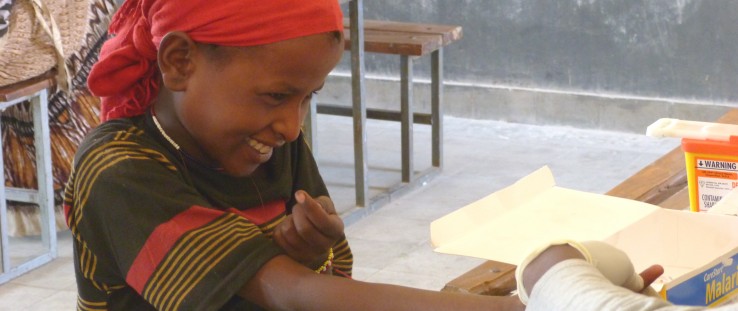 A young girl is tested for malaria during a school malaria survey in southern Ethiopia.
Malaria Consortium
A young girl is tested for malaria during a school malaria survey in southern Ethiopia.
Malaria Consortium
 A young girl is tested for malaria during a school malaria survey in southern Ethiopia.
Malaria Consortium
A young girl is tested for malaria during a school malaria survey in southern Ethiopia.
Malaria Consortium
In Gazipur, Bangladesh, a young mother embraces her healthy baby girl—only seconds ago unable to breathe, but aided by a skilled birth attendant using a simple bag and mask device designed to save newborns who experience asphyxia symptoms; while in Sokoto, Nigeria, a mother cuddles with her newly immunized child and remits a voucher for a free long-lasting insecticide-treated mosquito net.
In Katmandu, Nepal, a health worker applies a low-cost antiseptic gel to prevent an umbilical cord infection in a newborn; while in Busoga, Rwanda, a village community health worker gives three tablets of a lifesaving drug to stop a mother’s excessive bleeding after birth.
In Lufwanyama, Zambia, a nurse immunizes 6-week-olds to protect against pneumococcal disease, a leading cause of pneumonia; while in Wolisu, Ethiopia, a community health worker, also known as a health extension worker, weighs an infant during her third postnatal home visit.
In each of these settings, and in countless villages across the globe, health workers, nurses, midwives and doctors protect the health and well-being of newborns, toddlers, girls and boys, expectant mothers and other community members with simple, innovative and cost-effective solutions whose research and development were aided by USAID.
“USAID invests in research that pushes boundaries, advances health innovation, and uses disruptive technologies to accelerate progress, and supports a range of research activities, including both ‘upstream’ product research and ‘downstream’ implementation research,” said Neal Brandes, a senior health research adviser with USAID. “Along this continuum, USAID places a strong emphasis on evidence for informing development policies, practice and strategy.”
Disruptive technologies are advances and innovations that leapfrog current ones and alter the way people live and work.
In March, the Agency released its 2013 Health-Related Research Report with key updates in specific health areas.
For example, despite the fact that effective treatments exist for pneumonia, over 1.2 million children die each year from the disease. In the last few years, USAID has supported studies in Pakistan investigating the effectiveness of community-based treatment of severe pneumonia. Results from these studies have shown that oral antibiotics administered at home are as effective as injectable antibiotics administered in a hospital setting. This evidence prompted a 2012 revision of the World Health Organization guidelines on outpatient management of severe pneumonia.
USAID also validated a simplified approach to manage the third stage of labor that enables lower-level skilled birth attendants to properly manage 66 percent of poor contractions of the uterus, a cause of hemorrhage and death. During childbirth, women may suffer from potentially life-threatening conditions, such as excessive bleeding. Also known as postpartum hemorrhage, excessive bleeding can be prevented with a drug to make the uterus contract.
USAID also is working to increase access and improve quality of priority maternal health drugs: oxytocin, misoprostol and magnesium sulfate. Although these drugs have been used for years to treat the top two causes of maternal mortality, they have not been brought to scale due in part to challenges in drug quality and supply.
Through research, USAID demonstrated the efficacy of training community-level health professionals to manage asphyxia, a leading cause of newborn mortality. USAID, through a public-private partnership, is supporting early introduction of this approach in 24 partner countries by rolling out training and implementation research.
And the Agency supported scaling up in Nepal of chlorhexidine, or CHX, a very low-cost antiseptic used to prevent umbilical cord infections in newborns, a leading cause of newborn mortality. Cutting the birth cord with unsterilized instruments, and the application of substances such as ash, oil and cow dung by traditional birth attendants or family members increased risk of cord infection and death.
USAID partnered with Nepal’s Ministry of Health and Population to bring chlorhexidine to newborns in nearly all of Nepal’s districts. At 23 cents per dose, the drug is a scientifically proven innovation that has been shown to reduce up to a third of newborn deaths.
This is the second research product USAID has guided through a managed research-to-use process. The first product, oral rehydration solution and zinc, has been used as a treatment for diarrheal diseases in more than 20 USAID-supported countries. Product introduction for CHX is anticipated in at least 10 countries by 2016.
Zulfiqar A. Bhutta, head of the Division of Women and Child Health at Aga Khan University, was the principal investigator of a study that provides evidence that a simple low-cost solution like chlorhexidine can save lives, and shows that a delivery strategy through packaging in birth kits works. “These findings also have substantial implications for public health in South Asia, where many areas share similar cultural, social and economic characteristics,” he said.
USAID is also studying new treatments that would allow newborn sepsis care to be provided in lower-level health facilities on an outpatient basis or even outside health facilities. Sepsis is a bacterial infection in the blood. This new treatment approach promises to reach more sick newborns whose mothers do not currently access care and to reduce exposure to hospital-based pathogens and the cost of care.
CHX is only the latest example of the Agency using sound research to solve challenges in developing countries. Currently, USAID’s global health research and development portfolio includes investments in more than 100 technologies in various stages of development. Several of these technologies are expected to be launched within the next three years.
Keeping the Patient in Mind
As these products are developed, more research is needed to determine how they can be put into use in developing countries.
Take contraception, as one example. Increased use of family planning services allows couples to have smaller families and better invest in the health and well-being of each child. When more children survive and thrive, and policies ensure that jobs are made available to them when they are ready to enter the workforce, economic growth can be significantly accelerated, a phenomenon known as the demographic dividend, which has had significant effect in recent decades in Latin America and Asia.
For many women, currently available contraceptive methods don’t meet their needs. USAID-supported products on the verge of introduction include: a “one size fits most” reusable diaphragm that does not need clinical fitting; a long-term hormonal vaginal ring method completely under the woman’s control that lasts for one year; and a women’s condom, designed to be easy to insert, use and remove, making it unique compared to other female condoms. USAID prioritizes the development of new contraceptives that will be affordable in low-resource settings.
Also in the USAID pipeline is the Quan TB tool, a free downloadable electronic forecasting tool to improve planning and financing for TB treatment, including treatment for those co-infected with HIV. USAID is also supporting the development of PharmaCheck, a powerful, lightweight instrument that uses microfluidic technology to detect poor quality medicines. Field testing of the prototype is underway in Ghana.
“Many of the most significant achievements in human progress have come from harnessing the power of science, technology and innovation to accelerate economic development,” said Dr. Ariel Pablos-Mendez, who leads global health at USAID. “In health, new and better ways are being developed to deliver low-cost, high-impact health interventions capable of reaching more people, saving more lives and lowering costs.”







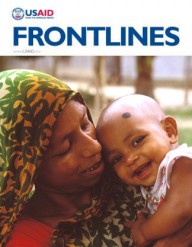

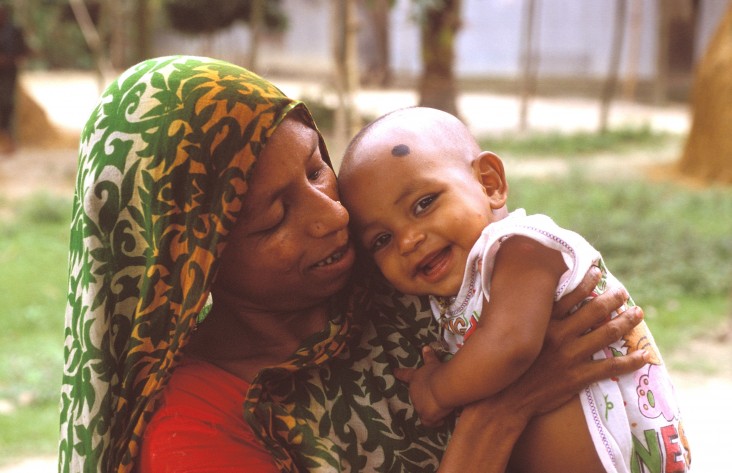
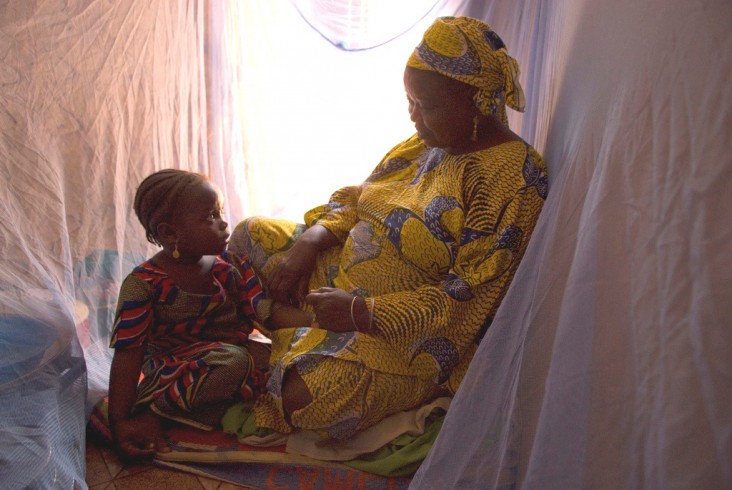
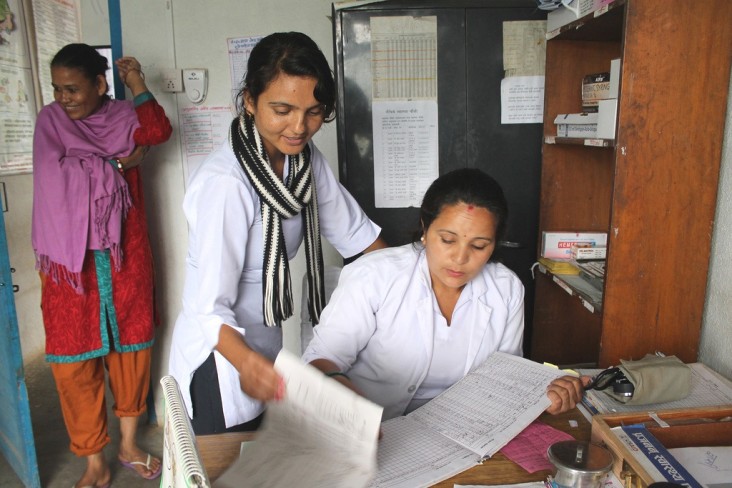

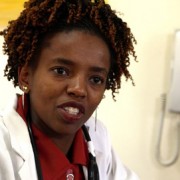
Comment
Make a general inquiry or suggest an improvement.